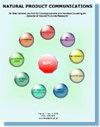贯叶连翘对硫代酰胺诱导的大鼠肝纤维化的急性毒性和肝保护作用
IF 1.4
4区 医学
Q4 CHEMISTRY, MEDICINAL
引用次数: 0
摘要
背景:贯叶连翘(MEHP)是一种广泛使用的治疗植物,具有多种生物活性。本研究评估了 MEHP 对硫代乙酰胺(TAA)诱导的大鼠肝损伤的急性毒性和保肝作用。研究方法:毒性试验包括给大鼠单次口服 2000 毫克/千克和 5000 毫克/千克的剂量。在保肝实验中,30 只成年大鼠被任意分为 5 组:正常大鼠(A)和 TAA 对照大鼠(B)每天接受蒸馏水治疗;参考大鼠每周口服 3 次 50 毫克/千克水飞蓟素;D 和 E 组大鼠每天分别口服 250 毫克/千克和 500 毫克/千克 MEHP。此外,B-E 组大鼠每周注射 3 次 200 毫克/千克 TAA,共 60 天。结果显示结果表明,大鼠在口服高达 5000 毫克/千克的剂量后没有出现任何中毒症状。肝脏保护评价显示,MEHP 处理的大鼠肝脏损伤明显减少,表现为肝脏指数和肝细胞增殖减少。组织病理学评估(H&E 和 Masson 三色染色)显示,MEHP 对大鼠肝脏病变的发生率有显著的抑制作用,表现为由 TAA 引发的肝坏死和纤维结缔组织增生减少。与纤维化对照组大鼠相比,MEHP治疗可显著减少肝实质组织中的增殖细胞核抗原和α-SMA(肌成纤维细胞),并改善氧化还原(SOD、CAT、GPx上调,MDA下调)和炎症状态(血清TNF-α和IL-6细胞因子减少)。此外,MEHP 还能显著恢复血清中的肝脏生物标志物(酶和蛋白质),防止 TAA 引起的肝毒性。结论MEHP目前的保肝作用可归因于其化学成分(金丝桃素、金丝桃素、槲皮素和对香豆酸),经过一些药理评估后,可将其作为肝纤维化的治疗添加剂。本文章由计算机程序翻译,如有差异,请以英文原文为准。
Acute Toxicity and Hepatoprotective Influence of Hypericum perforatum Against Thioactamid-Induced Liver Fibrosis in Rats
Background: Hypericum perforatum (MEHP) is a broadly used therapeutic plant exhibiting numerous bioactivities. The present study evaluates acute toxicity and hepatoprotective effects of MEHP against thioacetamide (TAA)-induced liver injury in rats. Methods: The toxicity trial included a single oral administration of 2000 and 5000 mg/kg to rats. In the hepatoprotective experiment, 30 adult rats were arbitrarily clustered into 5 groups: Normal (A) and TAA control rats (B) treated with daily distilled water; reference rats received 3 oral doses/week of 50 mg/kg silymarin; D and E, rats received daily doses of 250 and 500 mg/kg MEHP, respectively. In addition, group B-E received 3 injections of 200 mg/kg TAA in a week for 60 days. Results: The results have shown a lack of any toxic signs in rats following oral administration of up to 5000 mg/kg. The hepatoprotective evaluations revealed a noticeably lower hepatic injury in MEHP-treated rats shown by reduced liver index and hepatocyte proliferation. Histopathological evaluation (H&E and Masson trichrome stains) showed a significant inhibitory potential of MEHP on the incidence rate of hepatic lesions represented by decreased liver necrosis and lower fibrous connective tissue proliferation initiated by TAA in rats. MEHP treatment meaningfully decreased proliferating cell nuclear antigen and α-SMA (myofibroblasts) in liver parenchymal tissues as well as improved redox (up-regulated SOD, CAT, GPx, and down-regulated MDA) and inflammatory state (decreased serum TNF-α and IL-6 cytokines) compared to fibrosis control rats. In addition, MEHP treatment caused significant restoration of serum liver biomarkers (enzymes and proteins) against TAA-induced hepatotoxicity. Conclusion: The present hepatoprotectives of MEHP could be attributed to its chemical contents (hypericin, hyperforin, quercitrin, and p-coumaric acid) that may validate it as a therapeutic additive for liver fibrosis after some pharmacological evaluations.
求助全文
通过发布文献求助,成功后即可免费获取论文全文。
去求助
来源期刊

Natural Product Communications
工程技术-食品科技
CiteScore
3.10
自引率
11.10%
发文量
254
审稿时长
2.7 months
期刊介绍:
Natural Product Communications is a peer reviewed, open access journal studying all aspects of natural products, including isolation, characterization, spectroscopic properties, biological activities, synthesis, structure-activity, biotransformation, biosynthesis, tissue culture and fermentation. It covers the full breadth of chemistry, biochemistry, biotechnology, pharmacology, and chemical ecology of natural products.
Natural Product Communications is a peer reviewed, open access journal studying all aspects of natural products, including isolation, characterization, spectroscopic properties, biological activities, synthesis, structure-activity, biotransformation, biosynthesis, tissue culture and fermentation. It covers the full breadth of chemistry, biochemistry, biotechnology, pharmacology, and chemical ecology of natural products.
Natural Product Communications is a peer reviewed, open access journal studying all aspects of natural products, including isolation, characterization, spectroscopic properties, biological activities, synthesis, structure-activity, biotransformation, biosynthesis, tissue culture and fermentation. It covers the full breadth of chemistry, biochemistry, biotechnology, pharmacology, and chemical ecology of natural products.
 求助内容:
求助内容: 应助结果提醒方式:
应助结果提醒方式:


